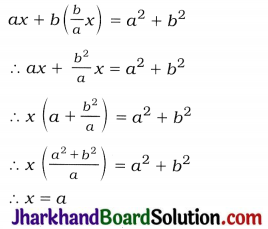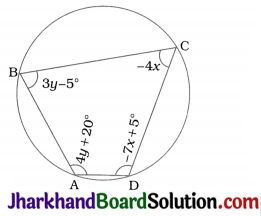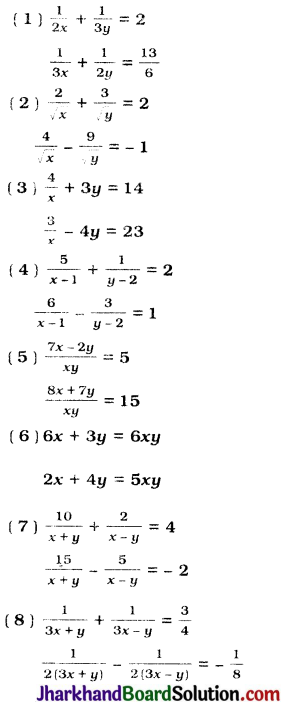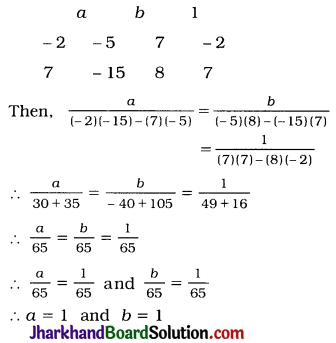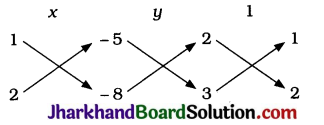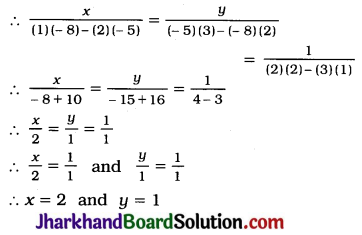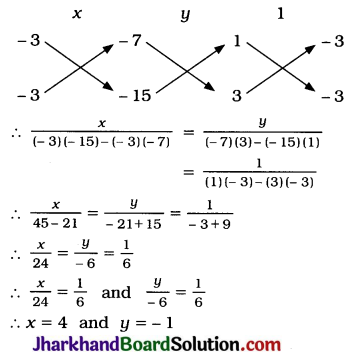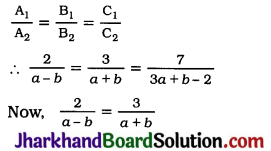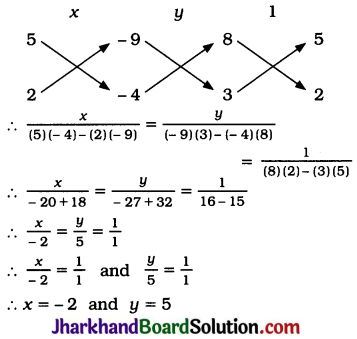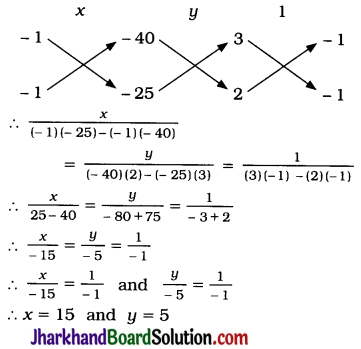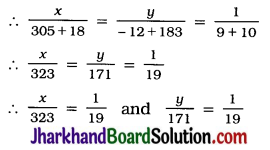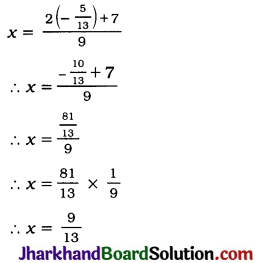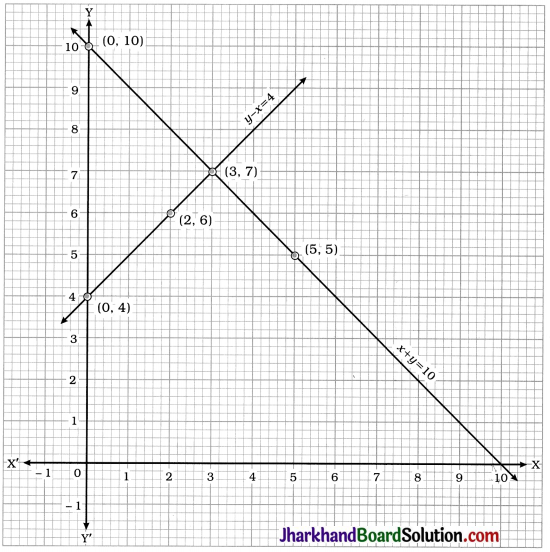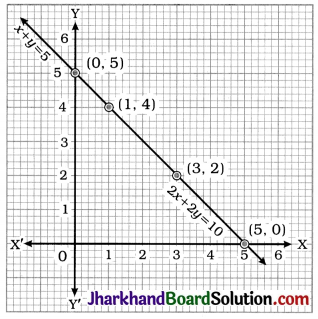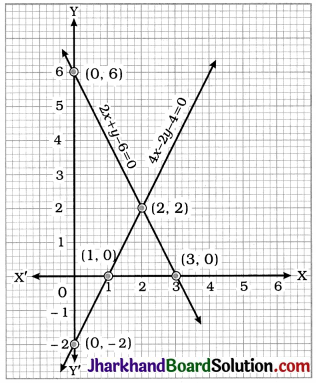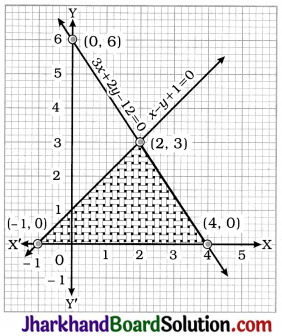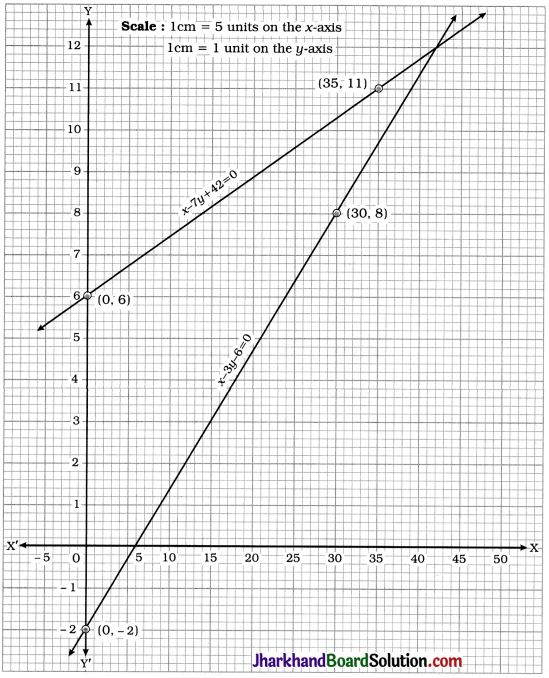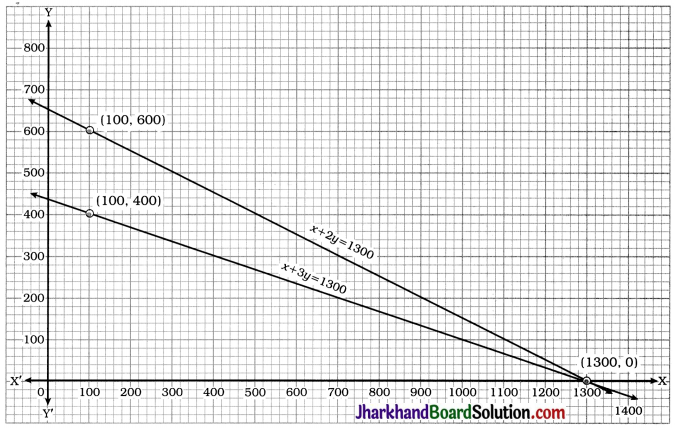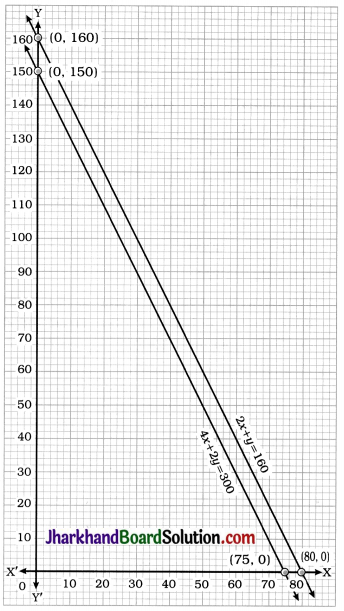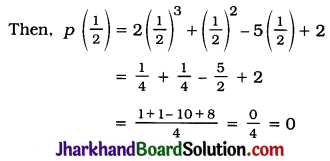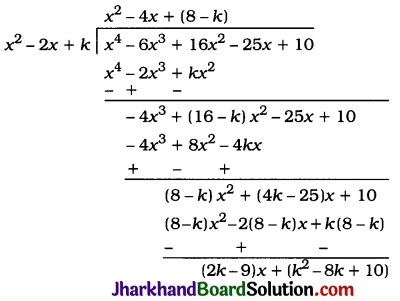Jharkhand Board JAC Class 10 Maths Solutions Chapter 4 Quadratic Equations Ex 4.3 Textbook Exercise Questions and Answers.
JAC Board Class 10 Maths Solutions Chapter 4 Quadratic Equations Exercise 4.3
Question 1.
Find the roots of the following quadratic equations, if they exist, by the method of completing the square:
1. 2x2 – 7x + 3 = 0
2. 2x2 + x – 4 = 0
3. 4x2 + 4\(\sqrt{3}\)x + 3 = 0
4. 2x2 + x + 4 = 0
Solution:
1. 2x2 – 7x + 3 = 0
Dividing throughout by 2, we get
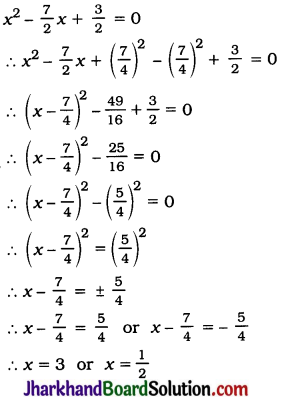
Thus, the roots of the given quadratic equation are 3 and \(\frac{1}{2}\).
2. 2x2 + x – 4 = 0
Dividing throughout by 2, we get
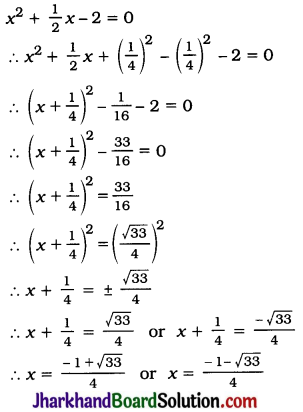
Thus, the roots of the given quadratic equation are \(\frac{-1+\sqrt{33}}{4}\) and \(\frac{-1-\sqrt{33}}{4}\)
3. 4x2 + 4\(\sqrt{2}\)x + 3 = 0
4x2 + 4\(\sqrt{3}\)x + (\(\sqrt{3}\))2 = 0
(2x + \(\sqrt{3}\))2 = 0
(2x + \(\sqrt{3}\)) (2x + \(\sqrt{3}\)) = 0
2x + \(\sqrt{3}\) = 0 or 2x + \(\sqrt{3}\) =0
x = \(-\frac{\sqrt{3}}{2}\) or x = \(-\frac{\sqrt{3}}{2}\)
Thus, the roots of the given quadratic equation are \(-\frac{\sqrt{3}}{2}\) and \(-\frac{\sqrt{3}}{2}\)
4. 2x2 + x + 4 = 0
Dividing throughout by 2, we get

But, the square of any real number cannot be negative.
Hence, the real roots of the given quadratic equation do not exist.
![]()
Question 2.
Find the roots of the quadratic equations given in Q.1 by applying the quadratic formula.
1. 2x2 – 7x + 3 = 0
Here, a = 2, b = -7 and c = 3.
Then, b2 – 4ac = (-7)2 – 4(2)(3) = 25
Now, x = \(\frac{-b \pm \sqrt{b^2-4 a c}}{2 a}\)
∴ x = \(\frac{7 \pm \sqrt{25}}{2(2)}\)
∴ x = \(\frac{7 \pm 5}{4}\)
∴ x = 3 or x = \(\frac{1}{2}\)
Thus, the roots of the given quadratic equation are 3 and \(\frac{1}{2}\).
2. 2x2 + x – 4 = 0
Here, a = 2, b = 1 and c = -4.
Then, b2 – 4ac = (1)2 – 4(2)(-4) = 33
Now, x = \(\frac{-b \pm \sqrt{b^2-4 a c}}{2 a}\)
∴ x = \(\frac{-1 \pm \sqrt{33}}{2(2)}\)
∴ x = \(\frac{-1 \pm \sqrt{33}}{4}\)
Thus, the roots of the given quadratic equation are \(\frac{-1 \pm \sqrt{33}}{4}\) and \(\frac{-1-\sqrt{33}}{4}\)
3. 4x2 + 4\(\sqrt{3}\)x + 3 = 0
Here, a = 4, b = 4\(\sqrt{3}\) and c = 3.
Then, b2 – 4ac = (4\(\sqrt{3}\))2 – 4(4)(3) = 0
Then, x = \(\frac{-b \pm \sqrt{b^2-4 a c}}{2 a}\)
∴ x = \(\frac{-4 \sqrt{3} \pm \sqrt{0}}{2(4)}\)
∴ x = \(-\frac{\sqrt{3}}{2}\) or x = \(-\frac{\sqrt{3}}{2}\)
Thus, the roots of the given quadratic equation are \(-\frac{\sqrt{3}}{2}\) and \(-\frac{\sqrt{3}}{2}\).
4. 2x2 + x + 4 = 0
Here, a = 2, b = 1 and c = 4.
Then, b2 – 4ac = (1)2 – 4 (2)(4) = -31 < 0
Since b2 – 4ac < 0 for the given quadratic equation, the real roots of the given quadratic equation do not exits.
Question 3.
Find the roots of the following equations:
1. x – \(\frac{1}{x}\) = 3, x ≠ 0
2. \(\frac{1}{x+4}-\frac{1}{x-7}=\frac{11}{30}\); x ≠ -4, 7
Solution:
1. x – \(\frac{1}{x}\) = 3, x ≠ 0
∴ x2 – 1 = 3x
∴ x2 – 3x – 1 = 0
Here, a = 1, b = -3 and c = -1.
Then, b2 – 4ac = (-3)2 – 4(1)(-1) = 13
Now, x = \(\frac{-b \pm \sqrt{b^2-4 a c}}{2 a}\)
x = \(\frac{3 \pm \sqrt{13}}{2(1)}\)
x = \(\frac{3 \pm \sqrt{13}}{2}\)
Thus, the roots of the given equation are \(\frac{3+\sqrt{13}}{2}\) and \(\frac{3-\sqrt{13}}{2}\).
2. \(\frac{1}{x+4}-\frac{1}{x-7}=\frac{11}{30}\); x ≠ -4, 7
∴ \(\frac{(x-7)-(x+4)}{(x+4)(x-7)}=\frac{11}{30}\)
∴ \(\frac{-11}{x^2-3 x-28}=\frac{11}{30}\)
∴ \(\frac{-1}{x^2-3 x-28}=\frac{1}{30}\)
∴ -30 = x2 – 3x – 28
∴ x2 – 3x + 2 = 0
Here, a = 1, b = -3 and c = 2.
Then, b2 – 4ac = (-3)2 – 4(1)(2) = 1
Now, x = \(\frac{-b \pm \sqrt{b^2-4 a c}}{2 a}\)
∴ x = \(\frac{3 \pm \sqrt{1}}{2(1)}\)
∴ x = \(\frac{3 \pm 1}{2}\)
∴ x = 2 or x = 1
Thus, the roots of the given equation are 2 and 1.
Note: Here, the method of factorisation would turn out to be more easier.
![]()
Question 4.
The sum of the reciprocals of Rehman’s ages (in years), 3 years ago and 5 years from now is \(\frac{1}{3}\). Find his present age.
Solution:
Let the present age of Rehman be x years.
So, his age 3 years ago was (x – 3) years and his age 5 years hence will be (x + 5) years.
The sum of the reciprocals of these two ages (in years) is given to be \(\frac{1}{3}\).
∴ \(\frac{1}{x-3}+\frac{1}{x+5}=\frac{1}{3}\)
∴ \(\frac{x+5+x-3}{(x-3)(x+5)}=\frac{1}{3}\)
∴ 3(2x + 2) = (x – 3)(x + 5)
∴ 6x + 6 = x2 + 2x – 15
∴ x2 – 4x – 21 = 0
∴ x2 – 7x + 3x – 21 = 0
∴ x(x – 7) + 3(x – 7) = 0
∴ (x – 7)(x + 3) = 0
∴ x – 7 = 0 or x + 3 = 0
∴ x = 7 or x = -3
Now, since x represents the present age of Rehman, it cannot be negative, i,e., x ≠ -3.
∴ x = 7
Thus, the present age of Rehman is 7 years.
Question 5.
In a class test, the sum of Shefali’s marks in Mathematics and English is 30. Had she got 2 marks more in Mathematics and 3 marks less in English, the product of those marks would have been 210. Find her marks in the two subjects.
Solution:
Let Shefali’s marks in Mathematics be x.
Then, her marks in English = 30 – x, as her total marks in Mathematics and English is 30.
Had she scored 2 marks more in Mathematics and 3 marks less in English, her score in Mathematics would be x + 2 and in English would be 30 – x – 3 = 27 – x.
∴ (x + 2) (27 – x) = 210
∴ 27x – x2 + 54 – 2x = 210
∴ -x2 + 25x + 54 – 210 = 0
∴ -x2 + 25x – 156 = 0
∴ x2 – 25x + 156 = 0
∴ x2 – 13x – 12x + 156 = 0
∴ x(x – 13) – 12(x – 13) = 0
∴ (x – 13)(x – 12) = 0
∴ x – 13 = 0 or x – 12 = 0
∴ x = 13 or x = 12
Then, 30 – x = 30 – 13 = 17 or
30 – x = 30 – 12 = 18
Thus, Shefall’s marks in Mathematics and in English are 13 and 17 respectively or 12 and 18 respectively.
![]()
Question 6.
The diagonal of a rectangular field is 60 metres more than the shorter side. If the longer side is 30 metres more than the shorter side, find the sides of the field.
Solution:
Let the shorter side of the rectangular field be x m.
Then, it diagonal is (x + 60) m and the longer side is (x + 30) m.
In a rectangle, all the angles are right angles.
Hence, by Pythagoras theorem,
(Shorter side)2 + (Longer side)2 = (Diagonal)2
∴ x2 + (x + 30)2 = (x + 60)2
∴ x2 + x2 + 60x + 900 = x2 + 120x + 3600
∴ x2 – 60x – 2700 = 0
Here, a = 1, b = -60 and c = -2700.
Then, b2 – 4ac = (-60)2 – 4(1)(-2700)
= 3600 + 10800
= 14400
Now, x = \(\frac{-b \pm \sqrt{b^2-4 a c}}{2 a}\)
= \(\frac{60 \pm \sqrt{14400}}{2(1)}\)
= \(\frac{60 \pm 120}{2}\)
∴ x = \(\frac{60+120}{2}\) or x = \(\frac{60-120}{2}\)
∴ x = 90 or x = -30
Since x denotes the shorter side of the rectangular field, x cannot be negative.
∴ x = 90
Then, x + 30 = 90 + 30 = 120
Thus, the shorter side (breadth) of the rectangular field is 90 m and the longer side (length) of the rectangular field is 120 m.
Question 7.
The difference of squares of two numbers is 180. The square of the smaller number is 8 times the larger number. Find the two numbers.
Solution:
Let the smaller number be x.
Then, the larger number = \(\frac{x^2}{8}\)
Now, the difference of their squares is 180.
∴ \(\left(\frac{x^2}{8}\right)^2-(x)^2=180\)
∴ \(\frac{x^4}{64}-x^2=180\)
∴ x4 – 64x2 – 11520 = 0
Let x2 = y
∴ x4 = y2
∴ y2 – 64y – 11520 = 0
Here, a = 1, b = -64 and c = -11520.
Then, b2 – 4ac = (-64)2 – 4(1)(-11520)
= 4096 + 46080
= 50176
Now, y = \(\frac{-b \pm \sqrt{b^2-4 a c}}{2 a}\)
= \(\frac{64 \pm \sqrt{50176}}{2(1)}\)
= \(\frac{64 \pm 224}{2}\)
∴ y = \(\frac{64+224}{2}\) or y = \(\frac{64-224}{2}\)
∴ y = 144 or y = -80
∴ x2 = 144 or x2 = -80
But, x2 = -80 is not possible.
∴ x2 = 144
∴ x = 12 or x = -12
Then, \(\frac{x^2}{8}=\frac{144}{8}=18\)
Thus, the required numbers are 12 and 18 or -12 and 18.
![]()
Question 8.
A train travels 360 km at a uniform speed. If the speed had been 5 km/h more, it would have taken 1 hour less for the same journey. Find the speed of the train.
Solution:
Let the usual uniform speed of the train be x km/h.
∴ Time taken to travel 360 km at the speed of x km/h = \(\frac{\text { distance }}{\text { speed }}\) = \(\frac{360}{x}\) hours.
If the speed had been 5 km/h more, the new speed would be (x + 5) km/h and the time taken to travel 360 km at this increased speed would be \(\frac{360}{x+5}\) hours.
Now, New time = Usual time – 1
∴ \(\frac{360}{x+5}=\frac{360}{x}-1\)
∴ 360x = 360x + 1800 – x(x + 5) (Multiplying by x(x + 5))
∴ 0 = 1800 – x2 – 5x
∴ x2 + 5x – 1800 = 0
∴ x2 + 45x – 40x – 1800 = 0
∴ x(x + 45) – 40(x + 45) = 0
∴ (x + 45) (x – 40) = 0
∴ x + 45 = 0 or x – 40 = 0
∴ x = -45 or x = 40
As, x is the speed (in km/h) of the train, x = -45 is not possible.
∴ x = 40
Thus, the usual uniform speed of the train is 40 km/h.
Question 9.
Two water taps together can fill a tank in \(9 \frac{3}{8}\) hours. The tap of larger diameter takes 10 hours less than the smaller one to fill the tank separately. Find the time in which each tap can separately fill the tank.
Solution:
Let the time taken by the tap with smaller diameter to fill the tank be x hours.
Then, the time taken by the tap with larger diameter = (x – 10) hours.
So, the part of the tank filled in one hour by the tap with smaller diameter = \(\frac{1}{x}\) and by the tap with larger diameter = \(\left(\frac{1}{x-10}\right)\)
So, the part of tank filled in one hour by both the taps together = \(\frac{1}{x}+\frac{1}{x-10}\)
Both the taps together can fill the tank in \(9 \frac{3}{8}\) hours, i.e., \(\frac{75}{8}\) hours.
∴ The part of tank filled in one hour by both the tank together = \(\frac{8}{75}\)
∴ \(\frac{1}{x}+\frac{1}{x-10}=\frac{8}{75}\).
∴ 75(x – 10) + 75x = 8x (x – 10) (Multiplying by 75x(x – 10))
∴ 75x – 750 + 75x = 8x2 – 80x
∴ 8x2 – 230x + 750 = 0
Here, a = 8, b = -230 and c = 750.
∴ b2 – 4ac = (-230)2 – 4 (8)(750)
= 52900 – 24000
= 28900
Now, x = \(\frac{-b \pm \sqrt{b^2-4 a c}}{2 a}\)
∴ x = \(\frac{230 \pm \sqrt{28900}}{2(8)}\)
∴ x = \(\frac{230 \pm 170}{16}\)
∴ x = \(\frac{400}{16}\) or x = \(\frac{60}{16}\)
∴ x = 25 or x = 3.75
But, x ≠ 3.75, because for x = 3.75, x – 10 < 0.
∴ x = 25 and x – 10 = 15
Thus, the time taken by the tap with smaller diameter is 25 hours and that by the tap. with larger diameter is 15 hours.
Question 10.
An express train takes 1 hour less than a passenger train to travel 132 km between Mysore and Bangalore (without taking into consideration the time they stop at intermediate stations). If the average speed of the express train is 11 km/h more than that of the passenger train, find the average speed of the two trains.
Solution:
Let the average speed of the passenger train be x km/h.
Then, the average speed of the express train is (x + 11) km/h.
∴ Time taken by passenger train to cover 132 km = \(\frac{132}{x}\) hours.
∴ Time taken by express train to cover 132 km = \(\frac{132}{x+11}\) hours.
Time taken by express train = Time taken by passenger train – 1
\(\frac{132}{x+11}=\frac{132}{x}-1\)
∴ 132x = 132(x + 11) – x(x + 11) (Multiplying by x(x + 11))
∴ 132x = 132x + 1452 – x2 – 11x
∴ x2 + 11x – 1452 = 0
Here, a = 1, b = 11 and c = -1452.
∴ b2 – 4ac = (11)2 – 4(1)(-1452)
= 121 + 5808 = 5929
Now, x = \(\frac{-b \pm \sqrt{b^2-4 a c}}{2 a}\)
∴ x = \(\frac{-11 \pm \sqrt{5929}}{2(1)}\)
∴ x = \(\frac{-11 \pm 77}{2}\)
x = 33 or x = -44
x = -44 is inadmissible as x represents the speed of the passenger train.
∴ x = 33 and x + 11 = 44
Thus, the speed of the passenger train is 33 km/h and the speed of the express train is 44 km/h.
![]()
Question 11.
Sum of the areas of two squares is 468 m2. If the difference of their perimeters is 24 m, find the sides of the two squares.
Solution:
Let the side of the smaller square be x m.
Then, the perimeter of the smaller square = 4x m
and the area of the smaller square = x2 m2.
From the given, the perimeter of the bigger square = (4x + 24) m.
∴ Side of the bigger square = \(\frac{4 x+24}{4}\) = (x + 6) m and hence, the area of the bigger square = (x + 6)2 m2.
∴ x2 + (x + 6)2 = 468
∴ x2 + x2 + 12x + 36 – 468 = 0
∴ 2x2 + 12x – 432 = 0
∴ x2 + 6x – 216 = 0
∴ x2 + 18x – 12x – 216 = 0
∴ x(x + 18) – 12(x + 18) = 0
∴ (x + 18) (x – 12) = 0
∴ x + 18 = 0 or x – 12 = 0
∴ x = -18 or x = 12
Here, x = -18 is not possible as x represents the side of a square.
∴ x = 12 and x + 6 = 18
Thus, the side of the smaller square is 12 m and the side of the bigger square is 18 m.


